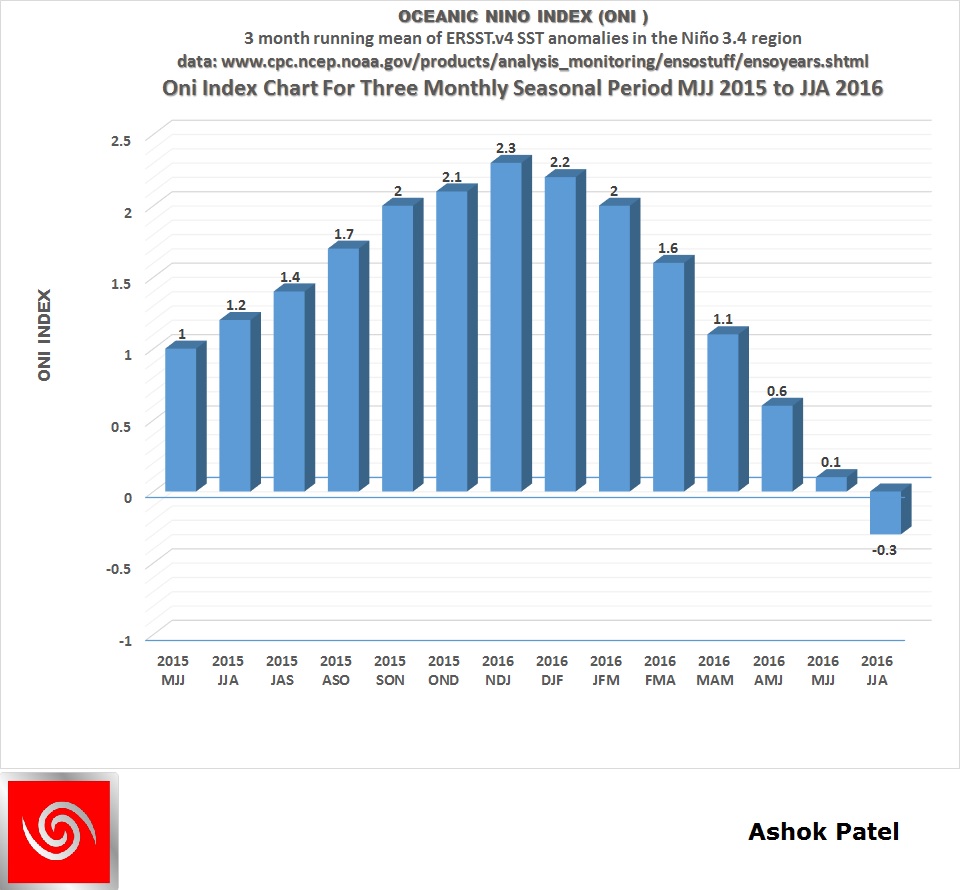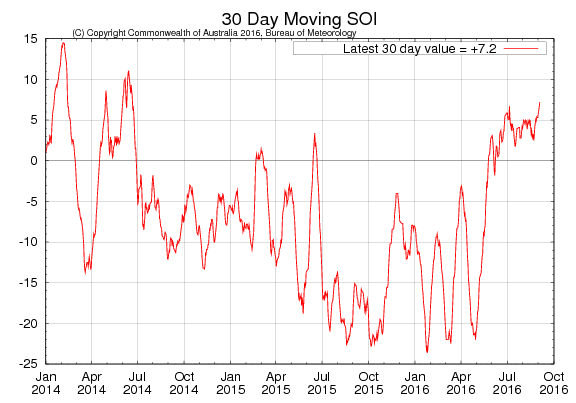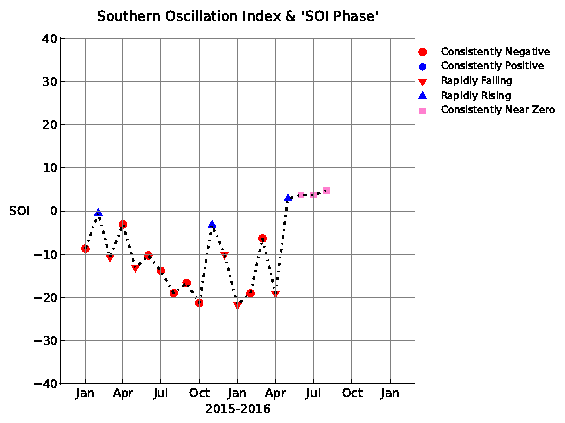El Nino Status on 6th September 2016
The ONI is based on SST departures from average in the Niño 3.4 region, and is a principal measure for monitoring, assessing, and predicting ENSO. Defined as the three-month running-mean SST departures in the Niño 3.4 region. Departures are based on a set of improved homogeneous historical SST analyses (Extended Reconstructed SST – ERSST.v4). The SST reconstruction methodology is described in Huang et al., 2015, J. Climate, vol. 28, 911-930).
CPC uses current Climatology based on 1986-2015 which has recently been changed from base years 1981-2010. Explanation about Climatology base years change is given here.
NOAA Operational Definitions for El Niño and La Niña El Niño: characterized by a positive ONI greater than or equal to +0.5ºC. La Niña: characterized by a negative ONI less than or equal to -0.5ºC. By historical standards, to be classified as a full-fledged El Niño or La Niña episode, these thresholds must be exceeded for a period of at least 5 consecutive overlapping 3-month seasons.
CPC considers El Niño or La Niña conditions to occur when the monthly Niño3.4 OISST departures meet or exceed +/- 0.5ºC along with consistent atmospheric features. These anomalies must also be forecast to persist for 3 consecutive months.
The current El Nino event ended at the end of July 2016. Due to change in Climatology from 1981-2010 to 1986-2015 there is again a change in the date as to when a full fledged El Nino was confirmed which now stands as at the end of February 2015 considering the SST departures from average in the Niño 3.4 region based on Extended Reconstructed SST – (ERSST.v4). The graph below shows that at the end of August 2016 an ENSO neutral conditions exists, the last available 3 monthly season being JJA 2016 which is -0.3ºC. Technically a full fledged La Nina can not develop during the year 2016, relying on the official NOAA definition for La Nina, because there has not been a single 3 -monthly season with La Nina thresh hold and now only four 3-monthly seasons are left after August 2016.
Latest Oceanic Nino Index (ONI) Graph till August 2016
The Table below shows the monthly SST of Nino3.4 Region and the Climate adjusted normal SST and SST anomaly for last two years. Climate Base 1986-2015.
Period Nino3.4 ClimAdjust YR MON Temp.ºC Temp.ºC ANOM ºC 2014 8 26.90 27.02 -0.12 2014 9 27.03 26.94 0.09 2014 10 27.25 26.91 0.34 2014 11 27.51 26.88 0.63 2014 12 27.40 26.80 0.61 2015 1 27.22 26.61 0.61 2015 2 27.25 26.80 0.45 2015 3 27.79 27.32 0.47 2015 4 28.59 27.86 0.73 2015 5 28.83 27.98 0.85 2015 6 28.70 27.76 0.94 2015 7 28.50 27.37 1.13 2015 8 28.47 27.02 1.45 2015 9 28.62 26.94 1.68 2015 10 28.86 26.91 1.95 2015 11 29.14 26.88 2.25 2015 12 29.04 26.80 2.24 2016 1 28.94 26.61 2.33 2016 2 28.89 26.80 2.09 2016 3 28.87 27.32 1.55 2016 4 28.97 27.86 1.11 2016 5 28.60 27.98 0.62 2016 6 27.82 27.76 0.06 2016 7 26.99 27.37 -0.38 2016 8 26.47 27.02 -0.55
June, July & August 2016 SST anomaly for Nino3.4 region is used to calculate the latest ONI Index for JJA 2016 as -0.3ºC. Since the latest ONI Index is below +0.5ºC and above -0.5ºC, ENSO neutral conditions prevail till end of August 2016.
CPC considers El Niño or La Niña conditions to occur when the monthly Niño3.4 OISST departures meet or exceed +/- 0.5°C along with consistent atmospheric features. These anomalies must also be forecast to persist for 3 consecutive months.
Southern Oscillation Index
As per BOM, Australia:
The latest 30-day Southern Oscillation Index (SOI) to 28 August 2016 is +4.9, within the neutral ENSO range. The 30-day SOI had dropped as low as +2.5 during the past fortnight. However, SOI was 7.2 on 4th September 2016.
Sustained positive values of the SOI above +7 typically indicate La Niña while sustained negative values below −7 typically indicate El Niño. Values between about +7 and −7 generally indicate neutral conditions.
SOI Monthly graph up to August 2016 as per The Long Paddock – Queensland Government.
SOI was +4.67 at the end of August 2016 and +7.08 on 5th September 2016 as per The Long Paddock – Queensland Government.
Summary by: Climate Prediction Center / NCEP Dated 1st August 2016
ENSO Alert System Status: La Niña Watch ENSO-neutral conditions are present.* Equatorial sea surface temperatures (SST) are near or below average in the east-central and eastern Pacific Ocean. La Niña is slightly favored to develop during August-October (ASO)2016, with about a 55-60% chance of La Niña during the fall and winter 2016-17.*
* Note: These statements are updated once a month (2nd Thursday of each month) in association with the ENSO Diagnostics Discussion, which can be found by clicking here
As per BOM -Australia 30th August 2016
Pacific remains ENSO-neutral – A La Niña WATCH remains in place.
In the tropical Pacific Ocean, sea surface temperatures are cooler than average, though remain well short of La Niña levels. In the atmosphere, there has been little change in trade winds or cloudiness, indicating little or no coupling between the atmosphere and ocean. As a result, cool sub-surface temperatures have eased slowly towards normal. International climate models suggest neutral to weak La Niña levels for the remainder of the year. A La Niña WATCH remains in place.
All earlier updates are listed below:
Click here for Update “Demise Of El Nino Brings ENSO Neutral Conditions At End Of July 2016”
Click here for Update “Moderate El Nino Persists Till End Of May 2016”
Click here for Update “Strong El Nino Persists Till April 2016”
Click here for Update “NOAA ERSST.v4 & ERSST.v3b & Effects On ENSO Events”
Click here for Update “Yet A Weak El Nino – 6th June 2105”
Click here for Update “El Nino Update – 5th May 2015”
Click here for Update “Weak El Nino Develops March 2015”
Click here for Update “El Nino Status – 6th March 2015”
Click here for Update “El Nino Status – 7th February 2015”
Click here for Update “El Nino Status – 6th January 2015”
Click here for Update “El Nino Status 6th November 2014”


